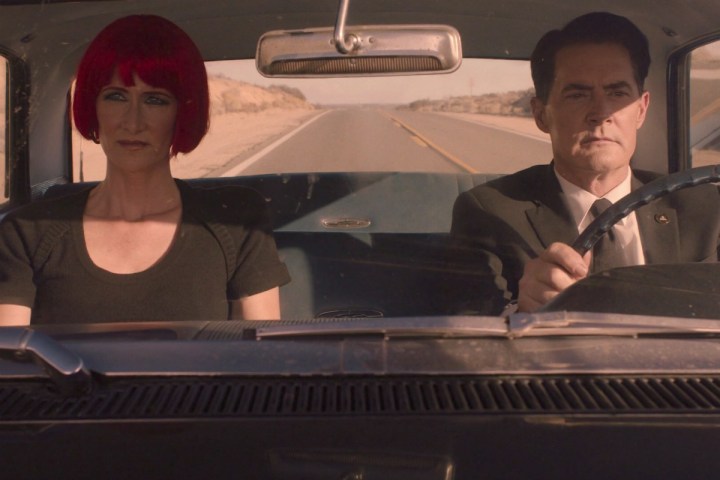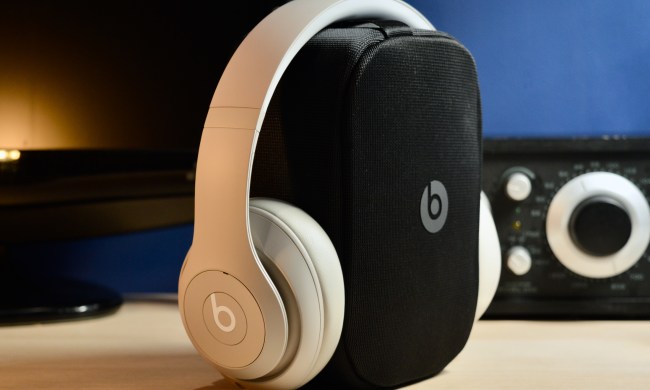
For those of you who spent the 25 years since the finale of the original Twin Peaks wondering what happens next, the fact that David Lynch and Mark Frost ended with yet another question may be frustrating. The finale of The Return — aired in two parts — concluded an 18-hour project that was frequently enchanting — and sometimes irritating — and ended in a way that raised far more questions than it answered. All that is left for viewers to do is to try and decipher what it meant.
A long-awaited reunion
For a while, Part 17 plays out like a relatively conventional finale. It opens with Gordon Cole (Lynch) explaining to Albert (Miguel Ferrer) and Tammy the truth behind the Blue Rose squad. Garland Briggs once made contact with an entity called “Jiao dai, later known as “Judy,” an “extreme negative force.” After Briggs and Phillip Jeffries (also involved with Judy) disappeared, Cooper took up the case.
Agent Dale Cooper (Kyle MacLachlan), who fully awoke in Part 16, makes his way to Twin Peaks. As he makes his approach, his doppelgänger gets there first, after the Fireman (Carel Struycken) teleports him to the sheriff’s station. There, Andy greets him, thinking he is the real Cooper, and directs him to Sheriff Truman, who is aware of Laura Palmer’s reference to “two Coopers” even if he doesn’t yet know what it means.
As Truman talks to the doppelgänger, he receives a call from the real Cooper, and immediately recognizes that something is off. The two men tense up, and reach for their guns. A shot rings out, and the camera pulls back to reveal that Lucy, standing in the doorway, has shot the evil Cooper.
The real Cooper shows up, his Vegas entourage in tow, as an orb of darkness (containing the face of BOB, the original show’s demonic villain) rises out of the doppelganger’s corpse. What ensues is an onslaught on the viewer’s senses, as the camera trembles and string instruments shriek. Freddie, the Englishman with a green-gloved hand of superhuman strength, fights the orb, eventually shattering it.
And so ends BOB, the malicious spirit who caused so much of the trauma throughout the show. Cooper banishes his doppelganger’s body back to the Black Lodge as his FBI comrades show up. A happy ending, seemingly. Then Cooper’s face is overlaid on the scene, and things start to get weirder.
Naido, the eyeless woman from the Black Lodge, transforms into Diane (Laura Dern), Cooper’s long-lost secretary, and they depart to the basement of the Great Northern Hotel, where Cooper uses his old room key to unlock a door. He steps through it and into the Black Lodge, where he meets with Phillip Jeffries, and then, of all things, the show cuts to a scene from Fire Walk with Me.

The scene in question depicts Laura Palmer (Sheryl Lee), the show’s original murder victim, a tragic incarnation of goodness, running off with and later fighting with her then-boyfriend, James. She stumbles into the woods, but the story plays out differently than it did in the film. She finds Cooper waiting there, offering to take her home. He leads her through the woods, and the camera cuts to one of the show’s most famous images, Laura Palmer’s body, wrapped in plastic, on the beach. The body disappears, and the opening scene from the very first episode plays out, sans corpse; Cooper has altered the very timeline of the show.
As this occurs, the show cuts to Sarah Palmer, who stabs her daughter’s iconic photo, and then Laura disappears from Cooper’s grasp.
The curtain call
It’s a bizarre conclusion to an otherwise straightforward episode, and Part 18 only makes the situation stranger. After revisiting Cooper’s trip through the Lodge in Part 3, the show depicts him and Diane driving through a desert, kissing before they pass through a rift into a different world. They stay at a motel, have sex, and Cooper awakens the next morning to find only a note, addressed to “Richard,” from “Linda,” asking him not to look for her.
Traveling to Odessa, Cooper seeks out a waitress. He knocks on her door, and the person who answers looks exactly like Laura Palmer, although she claims to be one Carrie Page. Cooper beseeches her to return to Twin Peaks with him, and she obliges, alluding to some trouble she needs to get away from. Cooper takes her to the Palmer residence, but is shocked to find that Sarah Palmer is no longer there; a woman calling herself Alice Tremond answers, and claims she has no knowledge of a Sarah Palmer owning the house.
“What year is this?” Cooper asks, and Carrie hears someone in the distance call out, “Laura!” She screams, and the lights in the house go out. Cut to credits.
What does it all mean?
Despite the seeming incoherence, one can put together a rough narrative of what happened after Cooper stepped through that door in the hotel. He somehow travels back to the past and leads Laura away from the horrible fate that awaits her, only to have Sarah Palmer — likely a host for the being called Judy, if her face-removal in a previous episode is any indication — snatching that victory away from him. He pursues his goal into a parallel world, where neither he nor Laura exist, only Richard and Carrie, and takes her to confront Sarah, only to have that confrontation denied as well.
While the events can be laid out (in more than a few ways) on paper, the question many viewers might ask is: “What was the point?”
Is Cooper’s mission a futile struggle to save a young woman who died too young? Twin Peaks: The Return denies Cooper a satisfactory conclusion to his work, and it denies the audience closure as well. The entire season was, in many ways, an exercise in thwarting expectations. Rather than a full season of beloved hero Dale Cooper, viewers got only a few episodes of him, and instead followed the misadventures of Dougie Jones.
Narrative has always been a mere tool in Lynch’s works, taking a back seat to atmosphere and imagery. Originally a painter, Lynch focuses on evoking emotion. His films take on the mercurial structure of dreams, and while dreams may depict events, and while we may organize these events into narratives that make sense to us, what matters is the mindset they leave us in. In the case of The Return, we are left despondent, wondering if the conflict between good and evil can ever be resolved, and if the struggle — Cooper’s struggle — is worth it.
It’s a bleak ending, but not necessarily without hope. Even in those last moments, Cooper is straining for answers, pacing, asking, “What year is this?” in an attempt to piece together the mystery. He is not yet ready to give up.
Twin Peaks: The Return is a difficult show, often teasing out or even withholding answers entirely. We may never find out what exactly happened to Audrey (Sherilyn Fenn). Was she still in a coma, dreaming of a life with her husband, Charlie, and all the happenings at the Roadhouse? The last we may ever see of her is a puzzled face staring into a mirror.
It has been suggested that Part 18 is more a season finale than an end to the series, leaving open some questions for another season or movie to answer. For now, that seems questionable. MacLachlan has stated that he has had no discussions about future episodes, according to Deadline. For now, what we’ve seen is what we get, and what we’ve seen is a season of television that fans will pick over for years, trying to piece together its secrets. Like Cooper, perhaps we are meant to search endlessly in pursuit of a satisfactory resolution.
For more Twin Peaks discussion, check out our roundup of the essential, classic episodes.




